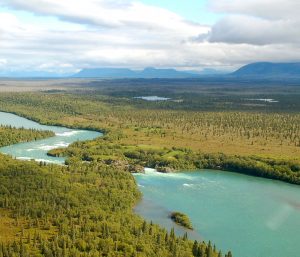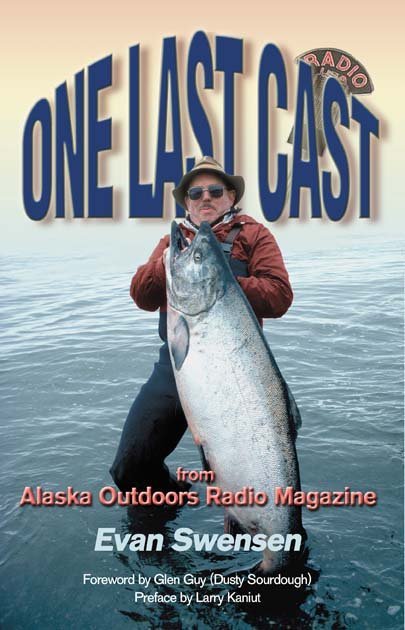One Last Cast
From Alaska Outdoors Radio Magazine
By Evan Swensen
Chapter Sixty-Five
Fishing the Newhalen River

Something got me thinking about fishing the Newhalen River. Although putting the trip together may require more planning than a trip along the road system, it can be satisfying and within almost anyone’s budget.
My first trip to the Newhalen River was in my old 1948 Stinson Voyager. My daughter, her friend, and her friend’s father completed our party. We flew through scenic Lake Clark Pass and landed at Iliamna. We parked the plane off the edge of the east-west dirt runway and took the 45-minute hike to the river.
The river was choked with red salmon. They were stacked up like cordwood. It was impossible to bring in our line without a fish. If we had a hookup and it got off, another took its place. We soon had our limit of six salmon apiece filleted and packed for our hike back to the plane. The balance of the day was spent fishing off the rocks for resident fish.
I was looking at the trip’s photographs recently, and a flood of pleasant memories flowed across my mind. Here’s how we made our memory, and any angler can duplicate our experience.
It’s a little over a mile to the river. You can either camp off the cross-runway or carry your gear to the river. Once you get to the river, you will see a group of rocks at the end of the river’s fast water. You can fish from these rocks. Downriver from these rocks, the river opens up into a wide delta. Immediately behind the rocks, the fast water meets with the still water of the delta and creates a long back eddy directly off the end of the rocks.
The best way I have found to fish here for resident fish is to stand on the rocks and cast as far as I can into the fast water of the main river. I let the current take my lure as far as it will before it swings into the back eddy. When the lure gets into the back eddy, I stop my line from going out, move to the left side of the rocks, and begin as slow a retrieve as possible without hooking up on the bottom. Once I get a fish on, I move as far and as quickly as possible to the rocks on the left so I can pull the fish out of the fast water and play him in the slow backwater of the eddy. If there is more than one fisherman on the rocks, we rotate our casts about one minute apart, keep out of each other’s way, and still catch fish without disturbing our partner.
My favorite lure for fishing the rocks is a small Spin-N-Glo. Use a three-way, in-line swivel and attach a pencil lead weight about 30 inches above the Spin-N-Glo. Adjust the weight size depending on the size line you are using and the amount of current you are fishing in.
An alternate setup is to use a split shot sinker tied three inches above a single egg or flesh fly. Again, cast out into the current as far as you can and let the fly drift into the back eddy. When the fly swings into the slow water, you will get a hookup if the fish are there and willing. Try a few casts with the same amount of line out, and then shorten your cast four feet and try again. Keep decreasing the length of your cast until you find the fish. Once you get into the hole, it has been my experience that you will have repeated takers.
You will catch a mixed bag of grayling, Dollies, and rainbow fishing from the rocks. But no matter the species of fish you catch and release, you will always catch and keep a pleasant memory.


